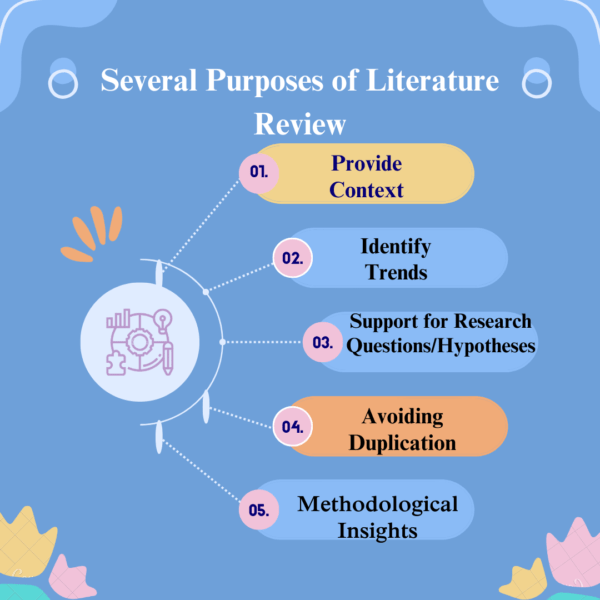Last updated on March 14th, 2024 at 05:58 pm

Table of Contents
ToggleWhat is Literature review
A literature review is an essential component of scholarly research, providing a comprehensive overview of previously published works on a particular topic. Whether it serves as a standalone scholarly paper or a section within a larger work, a literature review aims to synthesize existing knowledge and provide valuable insights into the chosen subject matter. In this guide, we’ll explore the various aspects of literature reviews, including their significance, preparation, organizational strategies, types, benefits, and more.
Significance of Literature Reviews
Literature reviews play a crucial role in the research process for several reasons:
1. Contextualization A literature review provides context for the current study by situating it within the broader body of existing literature. This helps readers understand the background and significance of the research question in a Research Article.
2. Identification of Gaps By reviewing existing literature, researchers can identify gaps or inconsistencies in the current knowledge base. This allows them to formulate research questions that address areas where further investigation is needed.
3. Credibility A well-constructed literature review demonstrates the author’s expertise and credibility in the field. It shows that the researcher is knowledgeable about existing literature and has carefully considered its implications for their own work.
4. Guidance for Future Research Literature reviews can guide future research directions by highlighting areas that warrant further exploration. They can also help researchers identify potential methodologies and theoretical frameworks for their studies.
Preparation Before Writing a Literature Review
Before embarking on the writing process, researchers should undertake the following preparatory steps:
1. Clarify Expectations Seek clarification from instructors or supervisors regarding the scope, depth, and expectations for the literature review. Understand the number and types of sources to include, as well as the preferred organizational structure.
2. Find Models Review existing literature reviews in the chosen field to understand common themes, methodologies, and organizational strategies. Analyze how other researchers have approached similar topics and consider adopting similar frameworks for your own review.
3. Narrow Your Topic Focus your literature review on a specific aspect of the chosen topic to ensure depth and coherence. Narrowing the scope of the review will also help you manage the volume of literature more effectively.
4. Consider Timeliness Assess whether sources need to be current based on the requirements of your discipline. In rapidly evolving fields, such as technology or medicine, recent literature may be more critical, while in other disciplines, historical context may be equally relevant.
Organizational Strategies for Literature Reviews
There are several strategies that researchers can employ when structuring their literature reviews:
1. Chronological Organize sources based on their publication dates to trace the evolution of ideas over time. This approach allows readers to understand how the literature has progressed and how ideas have evolved over different periods.
2. By Publication Order sources according to specific trends or shifts in research methodologies. This approach highlights changes in research approaches or paradigms within the field.
3. Thematic Group sources are based on common themes, concepts, or issues rather than chronological order. This approach allows researchers to explore different dimensions of the topic and identify recurring patterns or trends.
4. Methodological Organize sources based on the research methods employed in each study. This approach allows researchers to compare and contrast different methodological approaches and evaluate their strengths and limitations.
Types of Literature Review Articles
Literature reviews can take various forms, each serving specific purposes and objectives:
1. Narrative Reviews Narrative reviews provide a qualitative summary of existing literature on a particular topic. They offer insights into key themes, concepts, and debates within the field without seeking generalization or statistical analysis.
2. Descriptive or Mapping Reviews Descriptive reviews systematically classify and analyze existing literature to identify patterns or trends. They use structured search methods to gather a representative sample of studies and conduct quantitative analyses to summarize key findings.
3. Scoping Reviews Scoping reviews aim to provide an overview of the extant literature on an emergent topic. They help researchers understand the breadth and depth of existing research and identify gaps or areas for further investigation.
4. Systematic Reviews Systematic reviews rigorously aggregate, appraise, and synthesize empirical evidence to answer specific research questions. They adhere to explicit methodological guidelines and use systematic search strategies to identify relevant studies.
5. Realist Reviews Realist reviews focus on understanding how interventions work in different contexts. They examine the underlying mechanisms that drive outcomes and seek to explain variations in intervention effectiveness across diverse settings.
6. Critical Reviews Critical reviews provide a reflective analysis of existing literature, evaluating strengths, weaknesses, and inconsistencies. They help researchers identify areas for improvement and contribute to ongoing knowledge development within the field.
Benefits of Literature Reviews
Literature reviews offer several benefits to researchers, practitioners, and scholars:
1. Comprehensive Understanding By summarizing prior research on a topic, literature reviews help readers understand the current state of knowledge without having to sift through multiple sources.
2. Contextualization Literature reviews set the stage for further research by providing background and context for new studies. They help researchers situate their work within the broader scholarly conversation.
3. Research Guidance Literature reviews can guide the research process by identifying gaps, inconsistencies, or emerging trends in the literature. They help researchers formulate research questions and hypotheses based on existing knowledge.
4. Skill Development In the process of conducting literature reviews, researchers develop critical thinking, analytical, and writing skills. They learn how to evaluate and synthesize complex information and communicate their findings effectively.
In conclusion, literature reviews are a fundamental aspect of scholarly research, providing valuable insights into existing knowledge and guiding future research directions. By carefully preparing, organizing, and conducting literature reviews, researchers can contribute meaningfully to their fields and advance our collective understanding of complex topics. By mastering the art of literature reviews, researchers can navigate the vast landscape of scholarly literature and make significant contributions to knowledge creation and dissemination.
This comprehensive guide covers the essential aspects of literature reviews, offering valuable insights and practical advice for researchers at all levels. Whether you’re embarking on your first literature review or seeking to refine your skills, this guide serves as a valuable resource for navigating the complexities of scholarly research.

Born with a relentless thirst for knowledge, I ventured into academia, mastering the art of PHD thesis and dissertation writing. Fuelled by curiosity, I embraced digital marketing, deciphering its nuances to become an expert in SEO, content strategies, and social media management. Alongside, I delved into the intricacies of nursing assignments, leveraging my multidisciplinary insights to assist students. Each endeavor shaped my journey, blending scholarly pursuits with practical applications.
